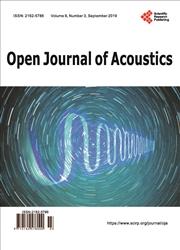New Method in Calculating the Trajectory of Sound Waves at Stratified Ocean
引用次数: 0
Abstract
There is a new method of calculating the trajectory of sound waves (rays) in layered stratified speed of sound in ocean without dispersion. A sound wave in the fluid is considered as a vector. The amplitudes occurring at the boundary layers of the reflected and refracted waves are calculated according to the law of addition of vectors and using the law of conservation of energy, as well as the laws that determine the angles of reflection and refraction. It is shown that in calculating the trajectories, the reflected wave must be taken into account. The reflecting wave’s value may be about 1 at certain angles of the initial wave output from the sours. Reflecting wave forms the so-called water rays, which do not touch the bottom and the surface of the ocean. The conditions of occurrence of the water rays are following. The sum of the angles of the incident and refracted waves (rays) should be a right angle, and the tangent of the angle of inclination of the incident wave is equal to the refractive index. Under these conditions, the refracted wave amplitude vanishes. All sound energy is converted into the reflected beam, and total internal reflection occurs. In this paper, the calculation of the amplitudes and beam trajectories is conducted for the canonical type of waveguide, in which the speed of sound is asymmetric parabola. The sound source is placed at the depth of the center of the parabola. Total internal reflection occurs in a narrow range of angles of exit beams from the source 43° - 45°. Within this range of angles, the water rays form and not touch the bottom and surface of ocean. Outside this range, the bulk of the beam spreads, touching the bottom and the surface of the ocean. When exit corners, equal and greater than 77°, at some distance the beam becomes horizontal and extends along the layer, without leaving it. Calculation of the wave amplitudes excludes absorption factor. Note that the formula for amplitudes of the sound waves applies to light waves.计算分层海洋声波轨迹的新方法
提出了一种计算无频散海洋分层声速下声波(射线)运动轨迹的新方法。流体中的声波被认为是矢量。根据矢量加法定律和能量守恒定律,以及决定反射角和折射角的定律,计算了反射波和折射波在边界层处的振幅。结果表明,在计算轨迹时,必须考虑反射波的影响。反射波的值在从源输出的初始波的某些角度可能约为1。反射波形成所谓的水射线,它不触及海洋的底部和表面。水射线发生的条件如下。入射波(射线)与折射波(射线)的角度之和应为直角,入射波的倾斜角的正切等于折射率。在这种情况下,折射波的振幅消失。声能全部转化为反射光束,发生全内反射。本文对声速为非对称抛物线的典型型波导的振幅和波束轨迹进行了计算。声源放置在抛物线中心的深度处。全内反射发生在距离光源43°- 45°的窄角度范围内。在这个角度范围内,水射线形成而不触及海洋的底部和表面。在这个范围之外,大部分光束扩散,接触到海底和海洋表面。当出口角等于且大于77°时,在一定距离处光束变为水平并沿层延伸而不离开层。波幅的计算不包括吸收因素。请注意,声波振幅的公式也适用于光波。
本文章由计算机程序翻译,如有差异,请以英文原文为准。
求助全文
约1分钟内获得全文
求助全文

 求助内容:
求助内容: 应助结果提醒方式:
应助结果提醒方式:


